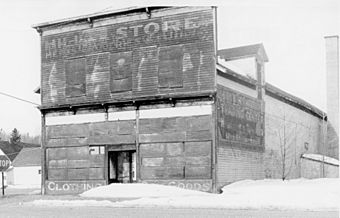Hill's Store facts for kids
|
Hill's Store
|
|
|
Formerly listed on the U.S. National Register of Historic Places
|
|

Hill's Store, 1970
|
|
| Location | Grand Marais Ave., Grand Marais, Michigan |
|---|---|
| Area | less than one acre |
| Built | 1895 |
| Demolished | 1973 |
| NRHP reference No. | 73002200 |
Quick facts for kids Significant dates |
|
| Added to NRHP | 1973 |
| Removed from NRHP | February 27, 1973 |
Hill's Store was once an important shop in Grand Marais, Michigan. It stood on Grand Marais Avenue. This old building was added to a special list called the National Register of Historic Places in 1973. This list helps protect important historical places. However, the store was torn down and removed from the list in the same year.
Contents
The Story of Hill's Store
Starting in Seney
In the 1890s, two business partners, Wilkes W. Hargrave and Roy C. Hill, ran a store. Their first store was located in a town called Seney, Michigan.
Moving to Grand Marais
Around 1895, the town of Seney began to shrink. So, Hargrave and Hill decided to move their business. They chose the town of Grand Marais. There, they built a new store and opened it to customers. They called their new shop "Hargrave and Hill."
Changing Owners and Names
The store stayed open for many years, until 1951. In 1915, Wilkes Hargrave sold his share of the business to Roy Hill. Roy Hill then ran the store by himself. Later, in the 1930s, Roy Hill sold the store to his son, Irving G. Hill. At this time, the store's name was changed to "Hill's Store."
The Store Closes
Hill's Store continued to serve the community until it finally closed its doors in 1951. After it closed, a company named Warren and Jacobites bought the store and everything inside it. However, they never reopened the business.
Demolition
Sadly, the historic Hill's Store building was torn down in 1973. It was removed from the National Register of Historic Places that same year.
What Hill's Store Looked Like
Hill's Store was a two-story building. It was made of wood and sat on a strong cement foundation. The front of the building had a special design called a "false front." This made the store look taller and more impressive. It also had a decorative top edge called a cornice.
The main entrance was in the middle of the front. On either side of the entrance were large windows, perfect for displaying items for sale. Inside, at the back of the building, there was a rope elevator. This was used to move goods between the two floors. The roof of the store had four small windows, called dormers, sticking out from it.

